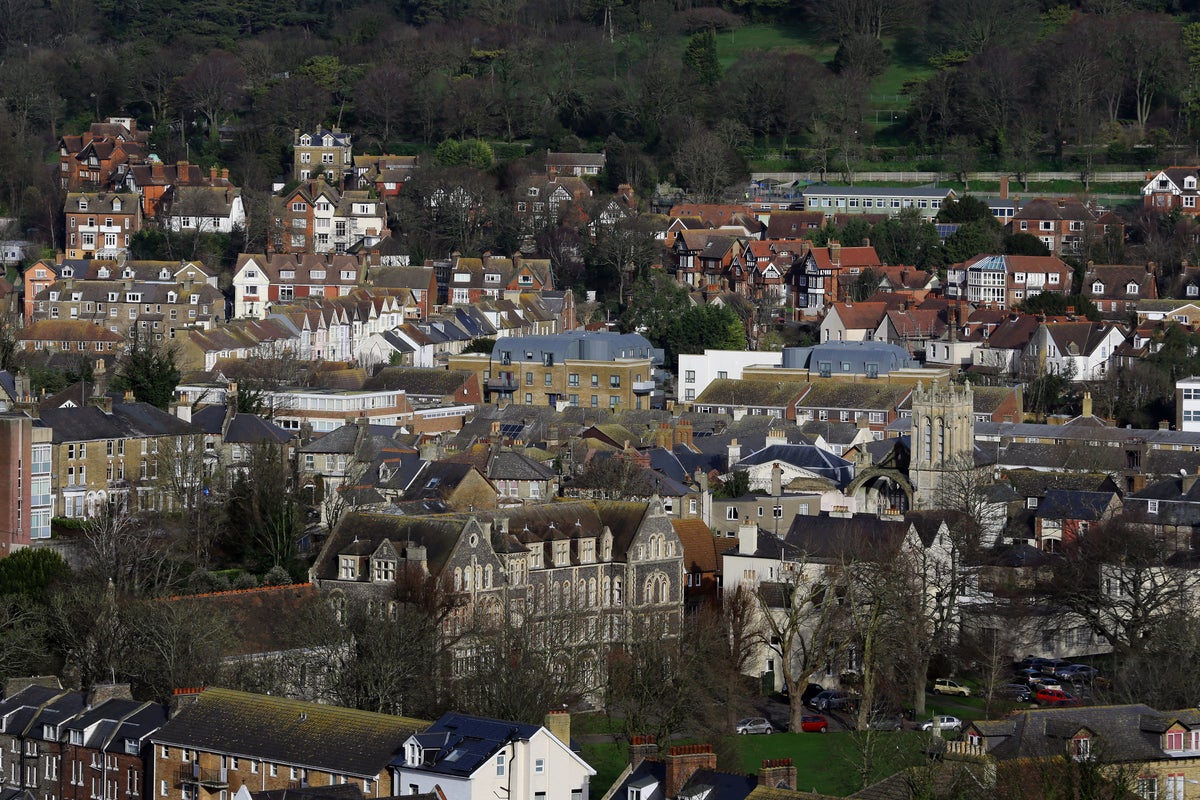
The average house price will be more than £22,000 higher than it is now in five years’ time, despite property values being expected to fall by 10% in 2023, according to a forecast.
The predictions, made by Savills, assume that house prices will start to recover from 2024 as interest rates and affordability pressures ease, after the expected fall next year.
First-time buyers and buy-to-let investors will bear the brunt of increased affordability issues next year, adding to pressures on rental prices, according to Savills’ predictions.
It also expects there will be a growing divide in terms of the ability to make property transactions between cash buyers or those with large amounts of equity in their home and those relying on mortgages to make a purchase.
This means that the “prime” – or top end – of the property market is predicted to hold up relatively strongly.
Cash buyers are often found in the prime property market – and so they are more cushioned against concerns about the ability to borrow at a time when mortgage rates are rising.
However, they may still be influenced by weaker housing market sentiment generally.
The prime housing market broadly refers to the top 5% to 10% of homes by value for the geographic region they are located in.
Savills expects that, for example, house prices in prime central London will fall by 2% next year – a much smaller decrease than the 10% drop expected generally across Britain.
Looking across Britain’s mainstream housing market, Savills expects that by the end of its forecast period, in 2027, the average house price will reach £381,578 – marking a £22,290 gain over the five-year period.
This would put the average house price at £92,000 above the level seen before the coronavirus pandemic, it said.
House prices have already risen sharply since March 2020, hitting a string of record highs.
The rarefied market in central London’s top postcodes continues to look good value in historical terms, particularly when seen in the context of the weaker sterling and strong dollar— Frances McDonald, Savills
Mainstream London and the south east of England are expected to see the largest house price falls in the short term and the weakest performance over the coming five years.
Frances McDonald, Savills research analyst, said London and the South East will then potentially be put “back in a position to deliver the strongest house price growth from 2027 onwards”.
London is the only region where Savills expects mainstream house prices to be lower in five years’ time, with a 1.7% fall predicted.
By contrast, house prices in prime central London are expected to be 13.5% higher in five years’ time.
“The rarefied market in central London’s top postcodes continues to look good value in historical terms, particularly when seen in the context of the weaker sterling and strong dollar,” said Ms McDonald.
“A price recovery in this market appears long overdue. This will help shield it from more significant price falls, though it increasingly looks like a stronger recovery in prices will not materialise in earnest before 2025, given the global economic backdrop and prospect of a UK general election in 2024.”
The wider South, which includes popular coastal locations in Cornwall, Devon and Norfolk, tends to see more cash buyers and so is also likely to be more resilient, according to the forecast.
Britain’s housing markets furthest from London, where mortgage affordability is least stretched, are expected to be the strongest performers over the five-year forecast period.
We expect to see prices fall by as much as 10% next year during a period of much-reduced housing market activity— Lucian Cook, Savills
Lucian Cook, Savills head of residential research, said: “A new Prime Minister and fiscal policy U-turns appear to have reduced some of the pressure on interest rates, but affordability will still come under real pressure as the effect of higher interest rates feeds into buyers’ budgets.
“That, coupled with the significant cost-of-living pressures, means we expect to see prices fall by as much as 10% next year during a period of much-reduced housing market activity.”
He added: “Meanwhile, rental value growth will continue to outpace earnings growth in the short term because of the pronounced imbalance between supply and demand, which will come as positive news to landlords already facing higher borrowing costs, but will put increasing pressure on struggling tenants.”
Here are Savills’ predictions for mainstream house price growth next year, followed by expected house price growth over the next five years to 2027:
– North West, minus 8.5%, 11.7%
– Yorkshire and the Humber, minus 8.5%, 11.7%
– North East, minus 8.5%, 11.7%
– Wales, minus 8.5%, 11.1%
– Scotland, minus 9.0%, 9.5%
– East Midlands, minus 9.0%, 8.9%
– West Midlands, minus 9.0%, 8.9%
– South West, minus 10.0%, 6.2%
– South East, minus 11.0%, 3.0%
– East of England, minus 11.0%, 3.0%
– London, minus 12.5%, minus 1.7%
– Average across Britain, minus 10.0%, 6.2%
And here are Savills’ forecasts for the prime housing markets in 2023, followed by the five years to 2027:
– Prime central London, minus 2.0%, 13.5%
– Outer prime London, minus 7.0%, 6.1%
– All prime regions, minus 6.5%, 9.9%







